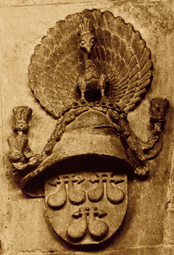St Mary's Bottesford Phase IV. Early Tudor
The Early Tudors 1440-1530
By Bob Sparham
The dynastic struggle for the English crown, which was known as the Wars of the Roses had interrupted the development of the Church after the construction of the Tower and Spire in 1420. Thomas Lord Roos IX like the rest of his family was a Lancastrian, and he was a close supporter of Henry VI and his powerful wife Margaret of Anjou. In 1461 after Henry’s defeat by the Yorkist Edward IV in the battle of Towton, the bloodiest battle in English history Thomas was captured and beheaded for high treason. BelvoirCastle and Thomas’ other lands were forfeited to the crown and were give by Edward IV to his favourite Lord Hastings. He let the Castle and, probably the Church fall into disrepair.
Edward IV’s brother Richard III (Shakespeare’s crouchback) was killed at the battle of Bosworth Field by Henry Tudor, who became Henry VII. In 1486, Henry VII passed an act of Parliament to restore Thomas; son Edmund Lord Roos to the Castle. It is probable that the Doom and Clerestory were built as a celebration of this restoration, particularly as one the contemporary carvings in the North side of the Nave,, shows the Roos coat of arms, underneath a sallet which is a type of helmet which was worn in the Wars of the Roses. These carvings are of considerable interest as a medieval artist chose the subject of animals particularly because of their usefulness as symbols for allegorical purposes. The characteristics and habits attributed by medieval writers to both real and imaginary were designed to make them affective as moral and religious models.
Thus we are shown animals such as the Dragon which is probably symbolic of Men’s tendency to think heretical thoughts. The medieval bestiaries explain that the dragon is the largest of all serpents and indeed the largest living thing on earth. Residing in Ethiopia or India, they make fiery heat and have fiery breath. Differing from the ancient dragon, who devours his victims, the medieval dragon’s strength is in his tail, which he uses to kill his victims. The St. Mary’s dragon has a representative of Satan on his tail because of the association of the Devil with dragons. The poor public image suffered by the dragon/serpent can be found in Genesis because it was the creature selected to tempt Adam and Eve to disobey God’s commandment. Based upon this biblical vilification, medieval iconography utilised the dragon as a symbol of evil and particularly of heresy. Most of the carvings in the church have a similar explanations











No Comments
Add a comment about this page